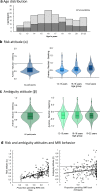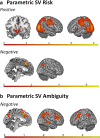Neural tracking of subjective value under riskand ambiguity in adolescence
- PMID: 31654233
- PMCID: PMC6861198
- DOI: 10.3758/s13415-019-00749-5
Neural tracking of subjective value under riskand ambiguity in adolescence
Abstract
Although many neuroimaging studies on adolescent risk taking have focused on brain activation during outcome valuation, less attention has been paid to the neural correlates of choice valuation. Subjective choice valuation may be particularly influenced by whether a choice presents risk (known probabilities) or ambiguity (unknown probabilities), which has rarely been studied in developmental samples. Therefore, we examined the neural tracking of subjective value during choice under risk and ambiguity in a large sample of adolescents (N = 188, 12-22 years). Specifically, we investigated which brain regions tracked subjective value coding under risk and ambiguity. A model-based approach to estimate individuals' risk and ambiguity attitudes showed prominent variation in individuals' aversions to risk and ambiguity. Furthermore, participants subjectively experienced the ambiguous options as being riskier than the risky options. Subjective value tracking under risk was coded by activation in ventral striatum and superior parietal cortex. Subjective value tracking under ambiguity was coded by dorsolateral prefrontal cortex (PFC) and superior temporal gyrus activation. Finally, overlapping activation in the dorsomedial PFC was observed for subjective value under both conditions. Overall, this is the first study to chart brain activation patterns for subjective choice valuation under risk and ambiguity in an adolescent sample, which shows that the building blocks for risk and ambiguity processing are already present in early adolescence. Finally, we highlight the potential of combining behavioral modeling with fMRI for investigating choice valuation in adolescence, which may ultimately aid in understanding who takes risks and why.
Keywords: Adolescence; Ambiguity; Parametric; Risk; Subjective value; fMRI.
Figures





References
Publication types
MeSH terms
LinkOut - more resources
Full Text Sources
Medical
Miscellaneous

